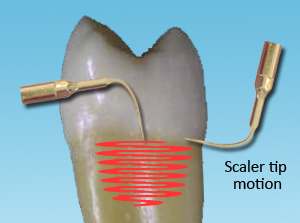Cavitron™ or Piezo? What’s the Difference, again?
Many hygienists are working part-time or temping and discover technology that may look familiar to them, but they can’t remember how to use it or what they learned in hygiene school or a course two years ago. When coaching in dental practices, I realized that the piezo ultrasonic is one of those devices that we remember how to use but can’t quite recall how it is different than a magnetostrictive ultrasonic scaler (also referred to as a Cavitron™). Often hygienists will come to me and say, “this (piezo) isn’t working. It needs to be repaired”. I will ask several questions, realize that the piezo IS working, and explain how it works differently. Here are a few things I explain are different:
First fun fact: Both a piezo and magnetostrictive are ultrasonic devices.
The second set of facts:
-
Frequency = INTERNALLY controlled (how frequently tip moves back/forth in 1 sec)
-
Amplitude (power) = CLINICIAN controlled by moving the dial
-
Amplitude = controls the DISTANCE or LENGTH of the tip movement
LOW POWER = LOW VIBRATIONS = LOW AEROSOL = INCREASED PATIENT COMFORT
Here are some differences between Magnetostrictive and Piezo Ultrasonics
Magnetostrictive
-
Uses metal stacks that energy moves through to create energy to activate the tip
-
Requires water to cool the stacks, so the device does not heat up
-
Can remove the calculus deposits in “chunks,” which is very satisfying to the clinician
-
The side and tip of the insert is active
-
Works in an elliptical (circular) pattern
Piezoelectric
-
Uses less water than a magnetostrictive
-
Has ceramic discs in the handle, requiring less water and easier to manage water
-
Lower amplitude, creating less vibration on the tooth
-
Patients report increased comfort because of less water and vibration
-
The side of the tip is active
-
Works in a linear pattern
-
Instead of “breaking off,” calculus typically disintegrates into small particles. I like to describe this as sand breaking off of a sandcastle
Tips and Inserts
A piezo uses tips shaped similarly to hand instruments. Companies such as Acteon offer 80 tips for various applications of hygiene, perio, endo, and restorative. Additionally, Acteon offers a pure titanium piezo tip (Implant Protect Tips) for use around dental implants.
Magnetostrictive uses inserts with a curved working end with varying degrees. Applications of magnetostrictive tips are limited to hygiene and perio only and typically come in 9 different styles. When a piezo is activated, the tip moves in a LINEAR (back and forth) motion, whereas a magnetostrictive has an ELLIPTICAL (circular) motion.
Both ultrasonics need a current to become active. Piezoelectric has crystals in ceramic discs, and Magnetostrictive has metal stacks. These metal stacks cause heat, so water is required in the handpiece to cool them. Because piezo does not have metal stacks, the handpiece does not require cooling. 50% LESS WATER is needed for all procedures with a piezo. Added benefits of using a piezo are: The tip never heats in the patient’s mouth, and there is no need to stop during treatment to re-fill and cool the handpiece.
Less cooling=minimal water More cooling=more water
How to Use the Piezo Tips
Use piezo like universal curettes and sickles. Some clinicians object to using a piezo because they fear not knowing how to use it, but if you know how to use Universal curets/sickles, you already know how to use it!
Here is the scoop:
When using the piezo tip, use the:
Sides
Not back
Not point
Not face
It is NOT the same as using a Gracey since a Gracey only has one working edge vs. Universal has two per end.
The piezoelectric is adapted at 0–5degree angulation compared to magneto at 15 degrees. If someone learned about magnetostrictive, they need to be aware to close the adaptation. A high-pitched sound will be produced if the angulation is too open with piezo. An open angulation is starting to use the back of the tip.
Piezo Scaler Tip Motion

Check Your Tips Weekly
Regardless of what which type of unit you use, don’t forget to check your tips with a weekly wear guide. Manufacturers will often include a wear guide with inserts or tips for you to use to measure tip loss.
2mm tip loss =
-
50% decrease in function
-
increases time
-
Increases aerosol/noise
Hopefully, you find this article helpful when discerning the difference between both ultrasonic devices. For more information on leading from the operatory and creating high-performance teams, follow me on Instagram or Facebook @nextleveldh, and we also have CE courses on demand at www.nextleveldentalhygiene.com,and listen to The Dental Handoff podcast.

Submitted by Dr Kelly Tanner, PhD, RDH